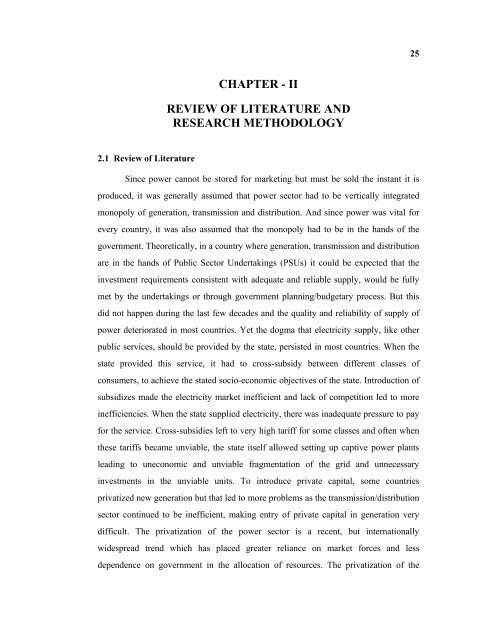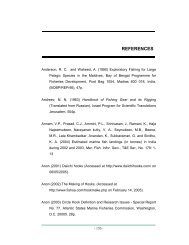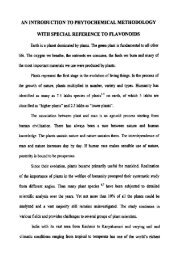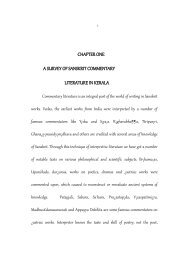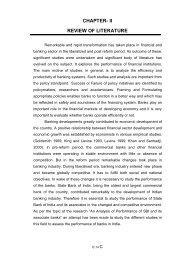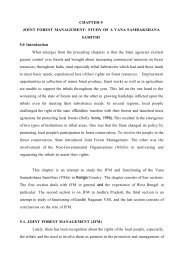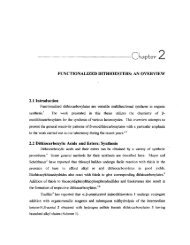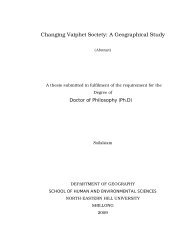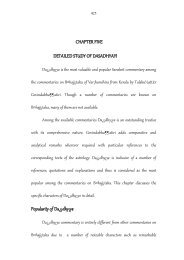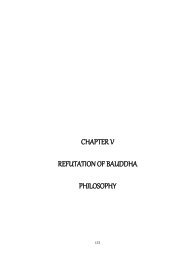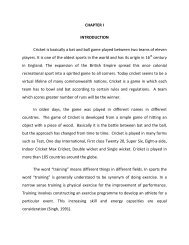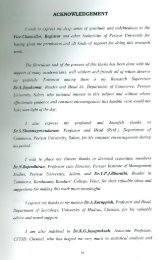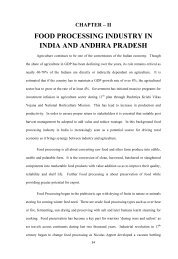chapter - ii review of literature and research methodology
chapter - ii review of literature and research methodology
chapter - ii review of literature and research methodology
You also want an ePaper? Increase the reach of your titles
YUMPU automatically turns print PDFs into web optimized ePapers that Google loves.
25CHAPTER - IIREVIEW OF LITERATURE ANDRESEARCH METHODOLOGY2.1 Review <strong>of</strong> LiteratureSince power cannot be stored for marketing but must be sold the instant it isproduced, it was generally assumed that power sector had to be vertically integratedmonopoly <strong>of</strong> generation, transmission <strong>and</strong> distribution. And since power was vital forevery country, it was also assumed that the monopoly had to be in the h<strong>and</strong>s <strong>of</strong> thegovernment. Theoretically, in a country where generation, transmission <strong>and</strong> distributionare in the h<strong>and</strong>s <strong>of</strong> Public Sector Undertakings (PSUs) it could be expected that theinvestment requirements consistent with adequate <strong>and</strong> reliable supply, would be fullymet by the undertakings or through government planning/budgetary process. But thisdid not happen during the last few decades <strong>and</strong> the quality <strong>and</strong> reliability <strong>of</strong> supply <strong>of</strong>power deteriorated in most countries. Yet the dogma that electricity supply, like otherpublic services, should be provided by the state, persisted in most countries. When thestate provided this service, it had to cross-subsidy between different classes <strong>of</strong>consumers, to achieve the stated socio-economic objectives <strong>of</strong> the state. Introduction <strong>of</strong>subsidizes made the electricity market inefficient <strong>and</strong> lack <strong>of</strong> competition led to moreinefficiencies. When the state supplied electricity, there was inadequate pressure to payfor the service. Cross-subsidies left to very high tariff for some classes <strong>and</strong> <strong>of</strong>ten whenthese tariffs became unviable, the state itself allowed setting up captive power plantsleading to uneconomic <strong>and</strong> unviable fragmentation <strong>of</strong> the grid <strong>and</strong> unnecessaryinvestments in the unviable units. To introduce private capital, some countriesprivatized new generation but that led to more problems as the transmission/distributionsector continued to be inefficient, making entry <strong>of</strong> private capital in generation verydifficult. The privatization <strong>of</strong> the power sector is a recent, but internationallywidespread trend which has placed greater reliance on market forces <strong>and</strong> lessdependence on government in the allocation <strong>of</strong> resources. The privatization <strong>of</strong> the
26power sector has been made possible after recognition that the sector could beseparated into generation, transmission <strong>and</strong> distribution sectors <strong>and</strong> even these sectorscan be broken into several companies, without compromising the economic advantages<strong>of</strong> a vertically integrated government monopoly, which earlier existed in mostcountries. The over-capitalized investments made by the governments in the electricitysector (generation, transmission <strong>and</strong> distribution) had resulted in high levels <strong>of</strong> reserveplant margin (coupled with poor availability) combined with high debt levels <strong>and</strong> lowreturns. Monetary restraints <strong>and</strong> debt placed pressures on most governments to reducegovernment expenditures <strong>and</strong> provide for better service to the people. It has now beenrecognize that introduction <strong>of</strong> private capital in the power sector, if properly structured<strong>and</strong> implemented, <strong>and</strong> lead to following advantages:Improve public finances through sale <strong>of</strong> state assets <strong>and</strong> elimination <strong>of</strong> subsidiesgradually.Improve performance <strong>of</strong> power entities by introducing competition betweendifferent players, primarily by creating a wholesale power market, giving higherreturns to those supplying power at lower rates.Lower consumer tariffs through creation <strong>of</strong> institutional framework for dealingwith consumer concernsAttract more investments, including foreign investment.Develop wider private share in key economic activityImprove revenue realization at all levels, thus making services more efficient.A number <strong>of</strong> studies have examined the effects <strong>of</strong> ownership <strong>and</strong> competitionon industrial performance, though mainly for developed countries. The main aspects <strong>of</strong>economic performance studied have been labor <strong>and</strong> total factor productivity, costs <strong>of</strong>production, pr<strong>of</strong>its <strong>and</strong> other financial ratios <strong>and</strong> prices the conclusions <strong>of</strong> these studiesare not completely consistent. This is true <strong>of</strong> those studies that have looked specificallyor in part at the experiences <strong>of</strong> the developing economies.
27Ros (1999), in his <strong>research</strong> examined the effects <strong>of</strong> privatization or competitionon key telecommunication variables , such as network expansion <strong>and</strong> efficiency Usinga fixed-effects model , the <strong>research</strong>er found that during the 1986—1995 time period,those countries that have at least 50% <strong>of</strong> the assets <strong>of</strong> their main telecommunicationprovider in the private sector have significantly higher main lines per 100 inhabitants<strong>and</strong> to a lesser degree have higher growth in the main lines per 100 inhabitants.Privatization is positively associated with main lines per employee <strong>and</strong> growth in mainlines per employee. While competition is not found to affect network expansion, it isfound to positively affected efficiency as measured in main lines per employee. The<strong>research</strong> also found that those countries that have at least fifty percent <strong>of</strong> the assets <strong>of</strong>their main telecommunications providers in the private sector <strong>and</strong> permit competitioneither in local , long-distance or international services have higher level <strong>of</strong> efficiencythan those countries that have either just privatized or permit competition.Ramamurti (1997) reports a staggering 370 percent increase in labourproductivity on the privatized Argentine railway. Just how far can privatization bepushed, <strong>and</strong> with what consequences? This <strong>research</strong> concludes that even large,unpr<strong>of</strong>itable firms in developing countries faced with marketing failures can beprivatized, but the gains <strong>of</strong> doing so depends on how badly the state enterprise wasperforming to begin with, <strong>and</strong> the potential for introducing competition in the market<strong>and</strong> for the market. The broader lesson is that when both market failures <strong>and</strong>government failures are present, a public-private solution is preferable to a purelyprivate or a purely public solution. Privatization is not a panacea but potentially apalliative, when it comes to reducing subsidies or coping with regulatory failures.Babalola (1999) in his <strong>research</strong> appraised the performance <strong>of</strong> Nigerianelectricity sector to find out the influence <strong>of</strong> ownership structures upon performance<strong>and</strong> productivity. The empirical analysis use two approaches for measuring efficiencyi.e. econometric <strong>and</strong> techniques <strong>and</strong> the non- parametric programming. Data relates toNigerian electricity industry from 1970-95.The empirical evidence suggest that that thegovernment involvement that curtail managerial autonomy might be an impediment toefficiency <strong>and</strong> performance. The <strong>research</strong> concluded that change <strong>of</strong> ownership <strong>and</strong>
28presence <strong>of</strong> regulator positively impacted the scale efficiency <strong>of</strong> the industry.Galal et al (1994), is a seminal contribution to the welfare analysis <strong>of</strong>privatization. In contrast to most empirical studies <strong>research</strong> on privatization,liberalization <strong>and</strong> regulation it focuses on welfare changes <strong>and</strong> not just on productivity<strong>and</strong> pr<strong>of</strong>itability or other business performance indicators. The <strong>methodology</strong> <strong>of</strong> thestudy is a social-cost benefit analysis. This is needed to compare the performance <strong>of</strong> thecompany after divestures with what the performance would have been under publicownership. The study was done to evaluate the welfare effects <strong>of</strong> one <strong>of</strong> the mostfamous episodes in privatization history in the 80’s, probably the one that actuallyshaped this policy in UK <strong>and</strong> rest <strong>of</strong> the world: the divesture <strong>of</strong> British Telecom. Thestudy concluded that the net social benefit is not robust <strong>and</strong> BT story is far from beingwarranted as success in welfare terms.Boubakri <strong>and</strong> Cosset (1998), in their study using a sample <strong>of</strong> 302 privatizedfirms across 43 countries over the period 1980-200, observed that share issueprivatization produce economically significant positive domestic market adjustedreturns. The finding further suggest that investors are relatively pessimistic at thebeginning <strong>of</strong> the privatization process because they are concerned about governmentpolicy uncertainties after privatization <strong>and</strong> hesitate to fully incorporate potentialpr<strong>of</strong>itability gains into their expectation for quite sometime thereafter. As per the<strong>research</strong> policy makers have to realize that investment in reputation building to boostinvestors confidence is important to reap highest benefits from the privatizationprocess, <strong>and</strong> help to achieve local stock market <strong>and</strong> over all economic growth.Boubkari also found more improvements in efficiency <strong>and</strong> output for firms in thecountries where stock markets are more developed <strong>and</strong> where property rights are betterprotected <strong>and</strong> enforced. Economic growth <strong>and</strong> foreign ownership are found to be otherkey determinants.Pasco-Font (2001) in its study tried to assess the income distribution effects <strong>of</strong>transformation <strong>and</strong> to determine which type <strong>of</strong> households bear the greater portion <strong>of</strong>the burden or enjoy the benefits <strong>of</strong> price changes brought in by privatization in Peru.
29For this purpose complementary methodologies are followed viz. concentration curves,dem<strong>and</strong> equations for utilities under study to calculate the welfare changes associatedwith the consumption <strong>of</strong> utilities. The study found that welfare gains reduced because<strong>of</strong> the jump in tariffs necessary for the viability <strong>of</strong> the sector. But the presence <strong>of</strong> newfirms entering the sector will bring rate down. In this respect, the role <strong>of</strong> regulatorbecomes vital for creating the necessary conditions that allow the new firms to enter themarket.Dewenter <strong>and</strong> Malatesta (2000), present empirical evidence on the relativepr<strong>of</strong>itability, leverage <strong>and</strong> labor intensity <strong>of</strong> government-owned <strong>and</strong> privately-ownedfirms. Cross-sectional analysis <strong>of</strong> a sample <strong>of</strong> very large firms indicates that thoseowned by governments are significantly less pr<strong>of</strong>itable than those held privately. Theyare also more highly leveraged <strong>and</strong> more labor intensive. They conducted a time seriesanalysis <strong>of</strong> privatized firms <strong>and</strong> find little evidence that privatization enhancespr<strong>of</strong>itability. In our sample pr<strong>of</strong>itability improves immediately before privatization. Theevidence on subsequent improvement is mixed. Some measures <strong>of</strong> pr<strong>of</strong>itability aresignificantly less after privatization than just beforeh<strong>and</strong>. The evidence suggests thatgovernments efficiently restructure at least some firms before selling them, but that theactual change <strong>of</strong> ownership does not give rise to further efficiency gains subsequently.Bhaskar <strong>and</strong> Kahn (1995) discover increased labor productivity in the privatizedBangladesh jute industry. In their <strong>research</strong> the <strong>research</strong>er uses firm level data from jutemills in Bangladesh for the year 1983-1988 to analyze the effects <strong>of</strong> privatization uponemployment <strong>and</strong> output. The privatization programme provided an almost controlledexperiment on the economic effects <strong>of</strong> a change in ownership. 31 <strong>of</strong> the 62 mills in thissector were privatized, with the rest remaining in the public sector. The selection <strong>of</strong> themills that were privatized was exogenous, as it was not based on the current financialperformance. The findings <strong>of</strong> the study are that privatization has large <strong>and</strong> significantnegative effect employment significantly, while the reduction in output is notsignificant.Petrazzini <strong>and</strong> Clark (1996) report that deregulation <strong>and</strong> privatization were bothassociated with significant improvements in the telephone density in 26 developing
30countries, although there appeared to be no obvious impact on service quality. Inappraising the performance <strong>of</strong> the electricity sector in developing countries it isimportant to take to account <strong>of</strong> the effects <strong>of</strong> ownership, competition <strong>and</strong> regulation,perhaps along with other institutional factors.Using 11 political variables, Bergara et al (1997) composed political indexes toexamine the effects <strong>of</strong> regulation. The empirical study <strong>of</strong> cross-nation analysis shedlights on the impact <strong>of</strong> political institutions <strong>and</strong> the ability <strong>of</strong> the governments tocommit to stable <strong>and</strong> non-opportunistic regulatory policies on the utility sectorperformance. They found that well-defined <strong>and</strong> credible political institutions werepositively <strong>and</strong> significantly related to electricity generation capacity. Policy makers indeveloping countries seeking to attract foreign investors to large sunk <strong>and</strong> politicallysensitive sectors should recognize that contractual terms, tax incentives <strong>and</strong> subsidiesonly function to an extent that they are credible. In the absence <strong>of</strong> substantiveconstraints on the government reneging on contract terms, investment will remain <strong>of</strong>fshore.Bortolotti et al (1998) in their study <strong>review</strong>s the main econometric <strong>and</strong> casestudy evidence on the impact <strong>of</strong> privatization on economic performance in developingcountries. The <strong>research</strong>er compared the performance <strong>of</strong> 12 large firms, mostly airlines<strong>and</strong> regulated utilities, in three developing economies, Chile, Malaysia, <strong>and</strong> Mexico,<strong>and</strong> one developed country, the UK. The study attempted to control for the counterfactual <strong>and</strong> used a performance <strong>methodology</strong> linked to social welfare maximization;although the study stops short <strong>of</strong> full equilibrium modeling. It endeavored to exploreboth the changes in economic efficiency <strong>and</strong> welfare aspects <strong>of</strong> privatization by lookingat the price <strong>and</strong> output changes <strong>and</strong> the impact on producer <strong>and</strong> consumer surplus.According to <strong>research</strong> privatization can improve economic performance, butperformance improvement lies on other structural reforms. Thus empirical evidence isconsistent with the notion that privatization works best in developing countries when itis integrated into broader development framework.Zhang.Y. et al (2005) in their study provides an econometric assessment <strong>of</strong> theeffects <strong>of</strong> privatization, competition <strong>and</strong> regulation on the performance <strong>of</strong> electricity
31generation industry using panel data for 36 developing <strong>and</strong> transitional countries, overthe period 1985-2003. Electricity sector in both developed <strong>and</strong> developing countrieshave been subject to restructuring to introduce private capital <strong>and</strong> increase competition.The study identifies the impact <strong>of</strong> these reforms on generating capacity, labourproductivity in the generation sector <strong>and</strong> capacity utilization. They used a fixed effectspanel data model. They found that establishing an independent regulatory authority <strong>and</strong>introducing competition before privatization is correlated with higher electricitygeneration, higher generation capacity <strong>and</strong> in the case <strong>of</strong> the sequence <strong>of</strong> thecompetition before privatization, improved capital utilization. The main conclusions arethat own their own privatization <strong>and</strong> regulation do not lead to obvious gains in theeconomic performance, though there are some positive interaction effects. By contrastintroducing competition does seem to be effective in stimulating performanceimprovements.Jamasb et al. (2004) in their study proposes a set <strong>of</strong> indicators for developing acoherent framework for studying the electricity reforms for studying electricity reformsin developing countries. The <strong>research</strong>ers classify approaches to analyzing electricityreforms into three broad categories: (i) econometric methods (<strong>ii</strong>) efficiency <strong>and</strong>productivity analysis methods, <strong>and</strong> (<strong>ii</strong>i) individual or comparative studies. According tothem, efficiency <strong>and</strong> productivity analyses are suitable for measuring the effectivenesswith which inputs are transformed to outputs, relative to best practice. Jamasb et al.(2004) also maintain that single or multi-country case studies are suitable when indepth investigation or qualitative analysis is needed. The proper study <strong>of</strong> economicreforms requires an analysis <strong>of</strong> its impact <strong>and</strong> an assessment <strong>of</strong> the role <strong>of</strong> those factorsthat were influential in determining its outcome. Any such analysis generally involvemeasuring (<strong>and</strong> there by quantifying) specific aspects <strong>of</strong> cause <strong>and</strong> effect. Almostinvariably, this involves using both quantitative <strong>and</strong> qualitative indicators.Steiner(2001) carried out a panel data analysis including electricity price, ratio<strong>of</strong> industrial to residential electricity price, ratio <strong>of</strong> industrial to residential electricityprice, capacity utilization rate <strong>and</strong> reserve margin. Using these variables, she tired tomeasure the competitive aspects <strong>and</strong> the cost efficiency <strong>of</strong> the reform. She also looked
32at some reform elements separately, including unbundling wholesale power pool, thirdparty access to transmission <strong>and</strong> privatization. The study found that electricity marketreforms generally induced a decline in the industrial price <strong>and</strong> an increase in the pricedifferential between industrial customers <strong>and</strong> residential customers, indicating thatindustrial customers benefit more from the reform. She also found that unbundling isnot associated with lower prices but is associated with a lower industrial to residentialprice ratio <strong>and</strong> higher capacity utilization rates <strong>and</strong> lower reserve marginsThe study by Ruffin (2003) dealt with the institutional determinants <strong>of</strong>competition, ownership <strong>and</strong> extent <strong>of</strong> reform in electricity reform process. Theinstitutional determinants <strong>of</strong> competition, ownership <strong>and</strong> extent <strong>of</strong> reform in electricityreform process. The institutional determinants employed are different measures <strong>of</strong>judicial independence, distributional conflict <strong>and</strong> economic ideology. The study <strong>of</strong> across-section OLS regression analysis <strong>of</strong> set <strong>of</strong> models with observations <strong>of</strong> up to 75developed <strong>and</strong> developing countries that reformed their electricity reform scores thatreflect the extent <strong>of</strong> the reform. The study found that the relation between judicialindependence on the one h<strong>and</strong>, <strong>and</strong> competition <strong>and</strong> ownership on the other isambiguous i.e. the coefficients are <strong>of</strong>ten insignificant or when significant, their signshifts across models. Besides, greater distributional conflict was found to besignificantly correlated with a higher degree <strong>of</strong> monopoly. Moreover, the resultsshowed that the relation between economic ideology favouring competition <strong>and</strong> privateownership was generally positive <strong>and</strong> significant. The results also pointed out that thereis appositive relationship between judicial independence <strong>and</strong> reform scores.Phadke et al. (2003) studied the electricity reforms in India <strong>and</strong> suggests that thechange in ownership through privatization alone cannot bring efficiency in the sector.The <strong>research</strong>er in his paper suggested that the success <strong>of</strong> electricity reforms in Indiawill depend critically upon the existence <strong>of</strong> some sort <strong>of</strong> restraining or discipliningmechanism in the sector, in the absence <strong>of</strong> which current efforts will likely result intransition from inefficient public ownership to pr<strong>of</strong>it gouging monopolies oroligarchies. In principle, such a mechanism should be strong, independent <strong>and</strong> effectiveregulatory oversight over public or private monopolies or significant competition
33among large number <strong>of</strong> public <strong>and</strong> private entities. But it is important to examinewithout bias, <strong>and</strong> as thoroughly as possible, the feasibility <strong>and</strong> effectiveness <strong>of</strong> boththese sector disciplining mechanisms before making any claims regarding thedesirability <strong>of</strong> privatization. The <strong>research</strong>er also argues that issues related to protectingthe environment, extending access to poor <strong>and</strong> other <strong>of</strong>f-grid populations <strong>and</strong> strategicconcerns related to import dependence <strong>and</strong> foreign-private ownership need to beaddressed up-front in order for reforms to be in broader public interest.Bacon & Jones (2001) in their study on privatization & liberalization <strong>of</strong>electricity sector in 14 developing countries viz. Albania, Argentina, Bolivia, BrazilColombia, Coted’ivorie, Georgia Hungary, India, Kazakhstan Mali Panama Thail<strong>and</strong>,Turkey <strong>and</strong> Ukraine concluded that competition for the right to enter the power marketon contractual or regulated terms plays an important role in developing countries,notwithst<strong>and</strong>ing the limited scope for sustaining competitive power pools. Likewise, alimited transparent <strong>and</strong> soundly structured process for sale <strong>of</strong> stakes in the powerentities will yield the best terms for the long term efficiency <strong>of</strong> the power sector. Thesequencing <strong>of</strong> reforms is crucial to their long term sustainability. First the legal <strong>and</strong>regulatory framework should be in place before privatization <strong>of</strong> the restructured powersupplier. Second, major restructuring should precede the creation <strong>of</strong> private ownershiprights to avoid problem with str<strong>and</strong>ed assets. Third, the scope for introducingcompetition to the whole sale power market should be incorporated into the initialstructure reforms to the power market rather than relying only in regulatoryinterventions.Nepal & Jamasb (2009) The <strong>research</strong> quantitatively explores high-level linksbetween power sector reforms <strong>and</strong> wider institutional reforms in the economy for a set<strong>of</strong> 27 diverse countries in rapid political <strong>and</strong> economic transition since 1990. Panel-dataeconometrics based on bias corrected dynamic fixed effect analysis (LSDVC) isperformed to assess the impact <strong>of</strong> reforms on macroeconomic <strong>and</strong> power sectoroutcomes. The results indicate that power sector reform is indeed a more complicatedprocess than initially perceived. The results also show that power sector reform isgreatly inter-dependent with reforms in other sectors in the economy. They concluded
34that the success <strong>of</strong> power sector reforms on outcomes in developing countries willlargely depend on the extent in which countries are able to synchronize inter-sectorreforms in the economy.Michael et al. (2003) suggested that in order to achieve success in the reformsthe measures like adoption <strong>of</strong> a legal <strong>and</strong> regulatory framework based on the principles<strong>of</strong> efficiency through competition market governance structure including anindependent regulator based on the principles <strong>of</strong> transparency <strong>and</strong> non-discriminationhave to be taken. A <strong>review</strong> <strong>of</strong> the power, water <strong>and</strong> transport sectors along with certainlegal <strong>and</strong> regulatory issues relating to PPI was carried out in eight countries : UnitedKingdom, Australia , Hungary, Brazil, Philippines, Argentina, Malaysia <strong>and</strong> Thail<strong>and</strong>The International experiences with competitive wholesale power markets has beenmixed. While some markets have seen supplies drop <strong>and</strong> prices skyrocket (as in the USstate <strong>of</strong> California), others have managed to attract higher private investment after themarket reforms. Throughout the process it is crucial for the government to publish theoverall policy on power market reform, <strong>and</strong> where possible the timetable <strong>and</strong> the scope<strong>of</strong> each step in the process so that investor can assess risks before investments. Inaddition existing investors will seek reassurance from the government that theirinvestments will be protected during the transition period.Fiorio et al. (2007) questioned the widespread believes that public ownershipcan be impediment to other reforms <strong>and</strong> that it to production inefficiency. To test forthus a reform paradigm in general, they considered electricity prices <strong>and</strong> survey data onconsumer satisfaction in the EU-5. Their empirical finding rejected the prediction thatprivatization leads to lower prices, or to increased consumer satisfaction. They als<strong>of</strong>ound that country specific features tends to have higher explanatory power <strong>and</strong> theprogress toward reform paradigm <strong>and</strong> is not systematically associates with lower prices<strong>and</strong> higher consumer satisfaction.Based on the <strong>literature</strong> <strong>review</strong> on cross-country studies related to electricitymarket reforms, we may argue that evidence on impact <strong>of</strong> the reform process is quitelimited <strong>and</strong> will take more time to emerge. Therefore there exists a huge <strong>research</strong> gap inthis area
352.2.1 Need <strong>of</strong> the Present StudyIndian economy is growing at a rate <strong>of</strong> more than 8% per annum. In order tosustain this growth it is essential to have a strong power infrastructure to support itLack <strong>of</strong> power will make high growth unsustainable. However, in India the dem<strong>and</strong> <strong>and</strong>supply gap is widening; where dem<strong>and</strong> is more than supply. The <strong>research</strong>er intends toexplore the reforms, <strong>and</strong> which reforms could be undertaken by the Indian governmentin future so that it overcomes dem<strong>and</strong> supply gap <strong>and</strong> doing the same efficientlykeeping in mind the limiting natural resources to achieve sustainable development. It isto make energy use smarter so that we get more out <strong>of</strong> existing potential supplies whilelooking to develop new resources. Many countries have undertaken reforms in thissector <strong>and</strong> have been quite successful in their implementation. Study <strong>of</strong> theirexperiences would prove very fruitful for Indian power sector.Some <strong>of</strong> the reasons for the shortage <strong>of</strong> supply are as follows: -The growth in the installed capacity is not enough to meet the growingdem<strong>and</strong>.Lack <strong>of</strong> optimum utilization <strong>of</strong> existing capacityInefficient use <strong>of</strong> electricity by the end consumer.Inadequate inter-regional transmission results in huge T&D losses.Technical losses account for about 8 to 10% losses. Loss due to theft <strong>and</strong>technical metering is about 12to 14%.Average cost <strong>of</strong> power is greater than average cost <strong>of</strong> revenue obtained.Skewed tariff system subsidizing agricultural <strong>and</strong> domestic consumers atexpenses <strong>of</strong> industrial consumers.Political interference <strong>and</strong> no firm policy on disconnectionTo reduce this gap Indian government has already undertaken certain reforms. Itwas like setting your own house in order. The reforms include:-Establishment <strong>of</strong> independent Electricity Regulatory Commissions (CERC& SERC) to develop markets <strong>and</strong> fix tariffs.
36Freedom to set up captive generation capacity including group captive.Intent to unbundled SEB’sPrivate players encouraged in power generation.To overcome the problem <strong>of</strong> high tariffs, policy for selection <strong>of</strong> generatorson competitive bidding.Mega projects policySetting up <strong>of</strong> power trading corporation Open access to consumers over 1 mw by 2009New hydel policy to provide thrust to hydro generationEnergy conservation Act in placeSettlement <strong>of</strong> outst<strong>and</strong>ing PSU bills with states.These reforms were just the beginning <strong>and</strong> are not enough. These reforms havenot addressed many other problems likeVirtually no time-<strong>of</strong>-day-prices (SPOT MARKET)Load duration curve.Different regulations (center vs. state ERC’s)Incase <strong>of</strong> RLDC’s vs. Transco, how should load dispatch be h<strong>and</strong>ledPower importUsage <strong>of</strong> information & Technology <strong>and</strong> many more.These reforms are just the beginning <strong>and</strong> are not enough to h<strong>and</strong>le the powercrisis. Power sector has many more challenges to face. If India aspires the status <strong>of</strong> adeveloped county it will have to overcome the problem <strong>of</strong> power shortage2.2.2 Scope <strong>of</strong> the StudyThe purpose <strong>of</strong> study is to overview the evolving policy environment <strong>and</strong>regulatory framework <strong>of</strong> India <strong>and</strong> Argentina electricity sectors <strong>and</strong> to makecomparison <strong>of</strong> the effects <strong>of</strong> privatization , competition & regulation on variousvariables between two countries so as to device the ways through which the problems
37<strong>of</strong> Indian electricity sector can be addressed in its second generation reforms.Using an original Panel Dataset for the period 1991-2008, the <strong>research</strong> providesthe analysis <strong>of</strong> the effects <strong>of</strong> privatization, competition & regulation in Power Sector <strong>of</strong>India & Argentina. The starting year <strong>of</strong> the study is 1991, as the reforms started in India& Argentina from this year. The final year 2008, represented the last year for which thedata were available at the time the <strong>research</strong> was conducted.The sample countries are India & Argentina. Argentina was chosen as a samplecountry because the restructuring process <strong>of</strong> the electricity sector that started in 1992fares among the most successful, both when compared to other sectors in Argentina <strong>and</strong>when compared to other electricity sector reforms in the world. It shares many <strong>of</strong> thefeatures <strong>of</strong> developing country’s electricity system. Like India, it is a Federal state <strong>and</strong>the provinces retain a large degree <strong>of</strong> over the regulation <strong>of</strong> local utilities including thepower to privatize local distribution utilities <strong>and</strong> to set residential prices. Argentinashares the political <strong>and</strong> macroeconomic instability like <strong>of</strong> India but is perhaps unusualin its capacity for designing <strong>and</strong> running sophisticated economic institutions such asthose required by a deregulated electricity market. Argentina has GDP growth <strong>of</strong> 7%as <strong>of</strong> India which is in the range <strong>of</strong> 7%-8% <strong>and</strong> faced the same challenges as beingfaced by India like power shortages, thefts, transmission , distribution losses, crosssubsidies,political interferences, inefficient use <strong>of</strong> power <strong>and</strong> lack <strong>of</strong> regulatorymechanism for free trade <strong>of</strong> power. The experience <strong>of</strong> Argentina in its implementation<strong>of</strong> power sector reforms provide fruitful experiences which can be incorporated in thesecond generation power reforms <strong>of</strong> India.The performance indicators used in this study are labour generation per capita,installed capacity per capita, installed generation per capita, net consumption per capita,electricity shortages, distribution losses <strong>and</strong> foreign direct investment. These indicatorscapture the extent <strong>of</strong> electricity available to the economy, labour generation <strong>and</strong>capacity utilization in the generation <strong>of</strong> electricity. There were many other indicators aswell that could not be included due to non availability <strong>of</strong> data.For finding the effects <strong>of</strong> privatization <strong>and</strong> competition on the performanceindicators correlation techniques have been used. To assess which form <strong>of</strong>
392.2 .4 (i) HypothesisIn the last twenty years the electricity power sector in both developed <strong>and</strong>developing countries has been subject to restructuring. Although the approaches toreform have varied across countries, the main objective has been to improve theeconomic efficiency <strong>of</strong> the sector by introducing private capital, liberalizing markets<strong>and</strong> introducing new regulatory institutions. In economic theory, ownership <strong>and</strong> thedegree <strong>of</strong> competition are both important factors in determining output levels, costs <strong>of</strong>production <strong>and</strong> prices. More formally, the capital market <strong>and</strong> the product marketdetermine the levels <strong>of</strong> allocative <strong>and</strong> productive efficiency. Therefore, privatization,competition <strong>and</strong> more effective state regulation <strong>of</strong> monopoly activities should lead toimproved economic performance. This depends, however, on the reforms beingappropriately designed <strong>and</strong> implemented. A country implementing reforms can sufferfrom serious institutional weaknesses, meaning that the planned reforms may notproduce their intended benefits. Thus, the impact <strong>of</strong> privatization, competition <strong>and</strong>regulation on the electricity sector may produce different results depending on thedesign <strong>and</strong> its implementationSince India & Argentina both, have carried reforms, but the <strong>methodology</strong> has beendifferent. In order to determine which method has been more powerful in bringing thedesired changes, the following hypothesis have been setH1: Privatization will bring in economic & productive efficiency in the powersector.H1.1 Privatization by way <strong>of</strong> green field projects than divestures will lead to higherlabour generation per capita.H1.2 Privatization by way <strong>of</strong> green field projects than divestures will lead to higherinstalled capacity per capita.H1.3 Privatization by way <strong>of</strong> green field projects than divestures will lead tohigher installed generation per capita.H2: Competition will stimulate both technical <strong>and</strong> productive efficiency in thepower sector.H2.1 Competition by not restricting the market share will lead to increase inconsumption per capita.
40H2.2 Competition by not restricting the market share will lead to decrease inenergy shortages.H2.3 Competition by not restricting the market share will lead to decrease indistribution losses.H3: A sound policy <strong>and</strong> regulatory framework <strong>and</strong> efficient supporting nstitutionsto enforce the relevant laws <strong>and</strong> regulations are imperative for FDI to enter<strong>and</strong> thrive2.2 .4 (<strong>ii</strong>) Reference PeriodUsing an original panel dataset for the period 1991-2008, the <strong>research</strong> providesthe analysis <strong>of</strong> the effects <strong>of</strong> privatization, competition & regulation in power sector <strong>of</strong>India & Argentina. The starting year <strong>of</strong> the study is 1991, as the reforms started in India& Argentina from this year. The final year 2008, represented the last year for which thedata was available at the time the <strong>research</strong> was conducted. The role <strong>of</strong> privatization,competition <strong>and</strong> regulation has been examined during this eighteen years time span.2.2.4 (<strong>ii</strong>i) Research DesignSince the study is about describing the state <strong>of</strong> affairs in the electricity sector asit exists at present <strong>and</strong> has no control over variables, therefore the <strong>research</strong>er hasundertaken Ex-Post facto <strong>research</strong>. Given that, the <strong>research</strong> involves comparisonbetween India & Argentina Electricity sectors, a Cross- National Policy SectorApproach (NPSA) is used.2.2.4 (iv) Data BaseThe data base for the present <strong>research</strong> is secondary which includes publisheddocuments <strong>of</strong> proven authenticity.Data source for the present <strong>research</strong> is secondary <strong>and</strong> has been derived fromvarious authentic documents. The indicators generation per capita, installed capacityper capita & net Consumption per capita were calculated based on data from U.S.Energy Information Administration, Asia Pacific Energy Research Centre (APERC),World Development Indicators published by the World Bank <strong>and</strong> from the database <strong>of</strong>the Ministry <strong>of</strong> power, Govt. <strong>of</strong> India & Ministry <strong>of</strong> power, Govt. <strong>of</strong> Argentina. Theemployment data used to calculate labour efficiency were compiled from the database
42Where P 1 = value <strong>of</strong> variable in year 1P 0 = value <strong>of</strong> variable in year 0(P 1 -P 0 )X100 = Percentage change in the variable during different periods <strong>of</strong> timeP 0n = Total number <strong>of</strong> years(<strong>ii</strong>i) CGR = Compound Growth raten=Antilog ∑ Log Xi =1n-1(P 1 -P 0 )Where X = X100 is the Percentage change in the value <strong>of</strong> variableP 0in time period from 0 to 1n= Total time period(iv) St<strong>and</strong>ard Deviation (S.D)n∑ (X i - X) 2i =1n-1WhereX = Arithmetic mean <strong>of</strong> variable X in= Number <strong>of</strong> observations(v) Pearson’s coefficient <strong>of</strong> correlation ( r )r=SS xySS x SS yWhereSS xy =n∑ (X i -X) (y i -y)i =1nSS x = ∑ (X i -X) 2i =1
43nSS y = ∑ (y i -y) 2i =1(vi) The formula for t value for testing for the existence <strong>of</strong> correlationt = r- ρ1-r 2n-2with the hypothesisH 0 : ρ = 0 (there is no correlation)H 0 : ρ 0 (there is correlation)Where ρ = Population correction coefficient (hypothesized =0)(n-2) = Degree <strong>of</strong> freedom(v<strong>ii</strong>) The formula for t value for testing <strong>of</strong> hypotheses for the mean (one sample t-test)t = X- μSnx = Sample meanμ = Population meanS = St<strong>and</strong>ard deviationDespite the above mentioned analytical tools, for interpretation purpose, thehelp <strong>of</strong> charts, diagrams, pie-chart, bar charts has also been sought wherever feltnecessary.2.2.5 Limitations <strong>of</strong> the studyThere are number <strong>of</strong> limitations in the <strong>research</strong> which are acknowledged asunder:-1. To begin with, the sample is composed <strong>of</strong> India & Argentina for which weobtained data on Privatization, Competition <strong>and</strong> Regulation to create ourvariables. There may be sample selection bias in the data provided by thesample countries. We have no reason to believe that this should be the case, butcannot <strong>of</strong> course rule it out.
442. Endeavour has been made to produce satisfactory measures <strong>of</strong> privatization,competition <strong>and</strong> regulation; more work would be valuable at an internationallevel to obtain superior measures especially on the effectiveness <strong>of</strong> regulation.3. Performance indicators like Quality <strong>of</strong> service could not be estimated because<strong>of</strong> lack <strong>of</strong> data.4. The impact <strong>of</strong> reforms on prices charged for electricity generated could not beestimated, as there is lack <strong>of</strong> sufficient comparable data across our sample <strong>of</strong>countries to carry out such an analysis.5. The time-period for the study has been taken from 1991-2008, but due to nonavailabilityfor some years has made some limits to the study.6. The effects <strong>of</strong> privatization, competition <strong>and</strong> regulation on performance are notseparately modeled, leaving open the possibility that economic gains attributedto privatization may have resulted from other structural reforms.2.2 .6 Organization <strong>of</strong> the studyThe whole study has been presented in six <strong>chapter</strong>s. Chapter I deals with theintroductory part in which conceptual <strong>and</strong> theoretical backdrop <strong>of</strong> Electricity SupplyIndustry. In the present <strong>chapter</strong> characterstics <strong>of</strong> electricity, The life cycle <strong>of</strong> electricpower, genesis <strong>of</strong> Electricity Supply Industry(ESI),Regulator, drivers for reforms inelectricity sector, process <strong>of</strong> liberalization <strong>of</strong> ESI & liberalization paradigm , expectedeffects <strong>of</strong> liberalization has been included. The purpose <strong>of</strong> this <strong>chapter</strong> is to havereadymade information about Electricity Supply Industry (ESI) <strong>and</strong> the reason forreforms in the industry.Chapter II is devoted to the <strong>review</strong> <strong>of</strong> previous related studies <strong>and</strong> <strong>research</strong><strong>methodology</strong> applied in the present study. In order to augment the knowledge base <strong>and</strong>derive analytical tools, umpteen <strong>review</strong>s <strong>of</strong> books, articles, <strong>research</strong> studies, papers,theses, which are <strong>of</strong> relevance to the study has been done with analytical <strong>and</strong> criticalaspects. In the same <strong>chapter</strong>, the need, scope, objectives <strong>of</strong> the present study have beenhighlighted. In the <strong>research</strong> <strong>methodology</strong> section <strong>of</strong> the present <strong>chapter</strong> the hypotheses,reference period, design <strong>of</strong> the <strong>research</strong>, database, data analyses tools including
45statistical tools, limitations <strong>of</strong> the study <strong>and</strong> its organization has been included.Chapter III is committed to the study <strong>of</strong> Power sector development in Indiawhich includes overview <strong>of</strong> the power sector before 1991, evolution <strong>of</strong> electricityreforms in India, the Enron affair, Orissa model <strong>of</strong> reforms & challenges before Indianpower sector to have first h<strong>and</strong> knowledge <strong>of</strong> the changes in power sector in India withthe implementation <strong>of</strong> reforms. The present scenario <strong>of</strong> power sector has also beenproduced in this section. In the same <strong>chapter</strong> a bird eye-view has been taken <strong>of</strong> theElectricity Act 2003, Open –access <strong>and</strong> Power trading in India. The objective <strong>of</strong> this<strong>chapter</strong> is to look into the policy <strong>and</strong> planning aspects <strong>of</strong> the Government regardingpower sector in India.Chapter IV is dedicated to the study <strong>of</strong> experiences <strong>of</strong> power sector reformsundertaken across globe with special focus on Argentina. It includes overview <strong>of</strong> theArgentinean power sector before 1991, evolution <strong>of</strong> reforms, the industry restructuring<strong>and</strong> privatizing plan , the structure <strong>and</strong> regulation <strong>of</strong> industry segments <strong>and</strong> challengesbefore Argentinean power sector. It also includes the detailed lessons from theArgentinean electricity sector reforms. The objective <strong>of</strong> this <strong>chapter</strong> is to look into theexperiences <strong>of</strong> the Argentinean power sector reforms so as to incorporate fruitfulexperiences in Indian power sector.Chapter V is related to the analytical part <strong>of</strong> the study. In this <strong>chapter</strong> the effects<strong>of</strong> privatization, competition <strong>and</strong> regulation has been analyzed. The performanceindicators selected for the study are labour generation per capita, installed capacity percapita, installed generation per capita, net consumption per capita , reduction inelectricity shortages, reduction in distribution losses <strong>and</strong> foreign direct investment. Thereference period <strong>of</strong> the study is 1991-2008.In this segment three main hypothesis <strong>and</strong>their sub hypotheses has been tested. The first hypotheses relates to privatization <strong>and</strong>finds the correlation between privatization <strong>and</strong> labour generation per capita, installedcapacity per capita, installed generation per capita in case <strong>of</strong> India & Argentina.Thereafter an attempt has been made to find out which form <strong>of</strong> Privatization is better byapplication <strong>of</strong> one sample T-test. Similarly in the second hypotheses correlation
46between competition <strong>and</strong> net consumption per capita , reduction in electricityshortages, reduction in distribution losses has been found in India & Argentina. Asimilar attempt has been made to find out which form competitions is better byapplication <strong>of</strong> one sample T-test. The last hypothesis relates to effect <strong>of</strong> regulation inattracting foreign direct investment. For this purpose t-test has been applied.Chapter VI throws a light on the findings <strong>and</strong> conclusions <strong>of</strong> the analysis. Thisalso includes the suggestion part. The last part <strong>of</strong> the study is for annexure,bibliography <strong>and</strong> references.


